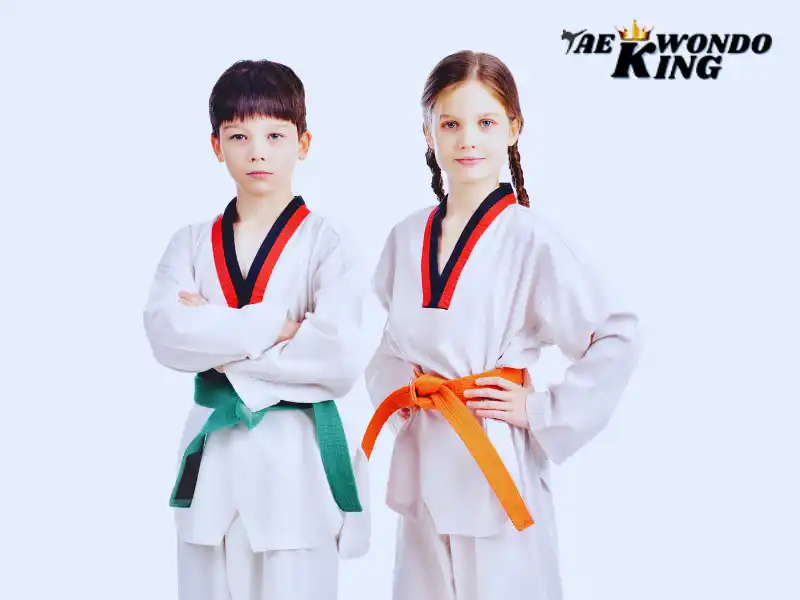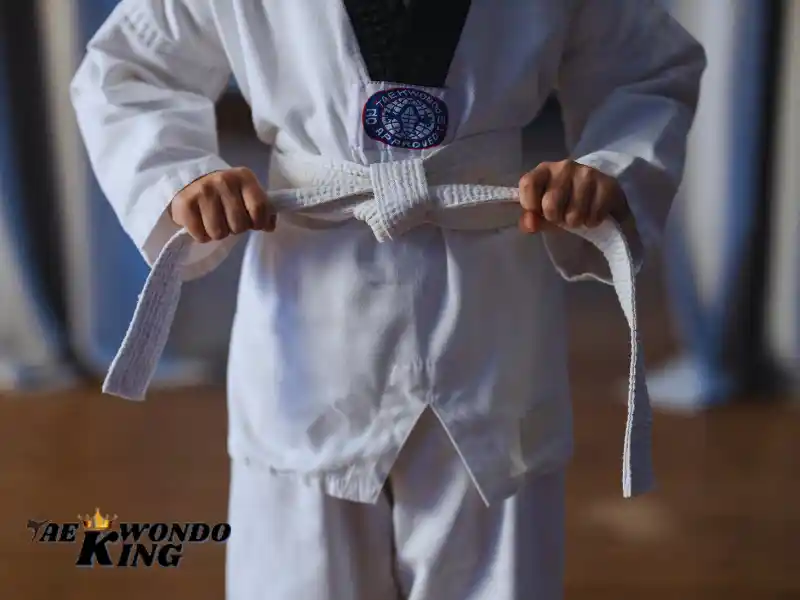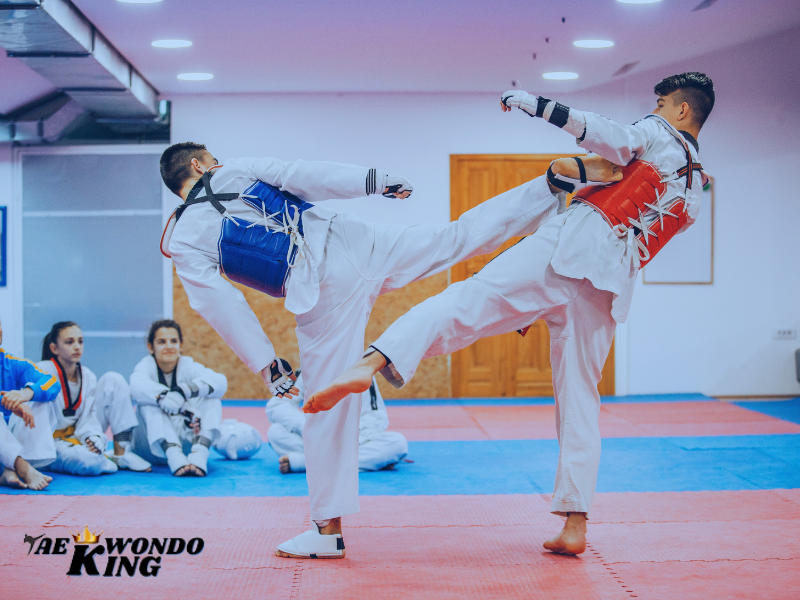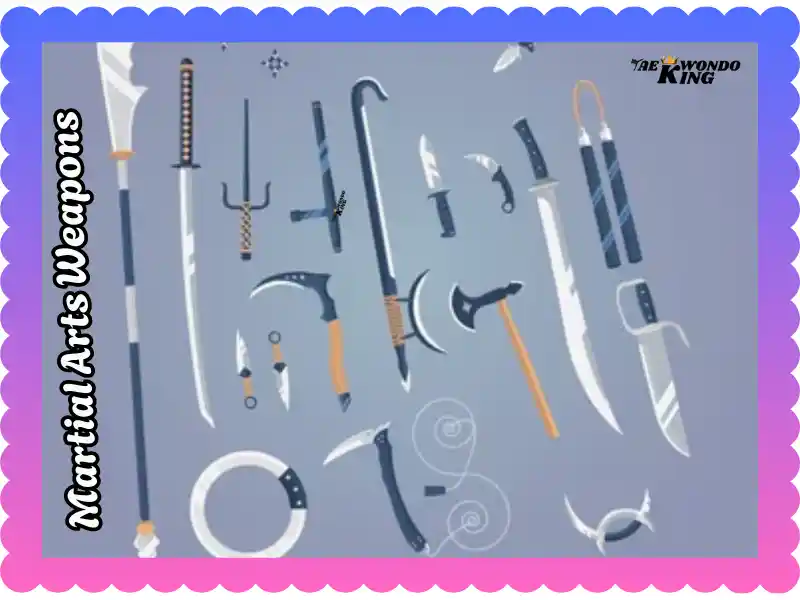
Have you ever wondered if Taekwondo, known for its powerful kicks. But Does Taekwondo use weapons? Most people think of fast strikes and high jumps. But there’s more to Taekwondo. Some traditional forms include weapons like the Jang Bong (staff) and Dan Bong (short stick). In my experience, these weapons can make your training even better. Let’s take a look at how weapons fit into Taekwondo and if they should be part of your practice!
Understanding the Role of Weapons in Taekwondo

Taekwondo is known for its fast kicks, but it also uses weapons. When I started training with weapons like the Jang Bong (staff), it added a new layer to my practice. Weapons help teach balance, control, and focus. In this section, we’ll look at how weapons fit into Taekwondo and why they matter.
Do Taekwondo Practitioners Use Weapons?
When you think of Taekwondo, you probably picture fast kicks and punches. But did you know that some Taekwondo styles use weapons? Taekwondo is mostly about striking, but some styles teach weapon use. This part of training can make Taekwondo even more interesting. Weapons are taught in some schools, especially in advanced classes.
Traditional Weapons in Taekwondo
Weapons in Taekwondo come from old Korean martial arts. They have a lot of history and meaning. In the past, warriors trained with weapons to defend themselves. Jang Bong (the staff) and Dan Bong (short staff) were used by warriors. There are also Gum Do (sword) and Dan Do (knife). These weapons help teach control and focus, just like punches and kicks.
Why Weapons Aren’t Central to Taekwondo
Weapons aren’t the main focus of Taekwondo. Taekwondo mainly teaches how to strike with your hands and feet. The art started as a way to develop speed and power. But weapons are part of the tradition. They come from the martial art’s military past, where soldiers used weapons in battle. Some schools teach weapons, but they are not required for everyone. Weapons training can add depth to Taekwondo. It’s something extra for those who want to learn more.
In my experience, learning the Jang Bong gave me new skills. It taught me control and timing. Using a weapon added another layer to my training.
Types of Weapons Used in Taekwondo
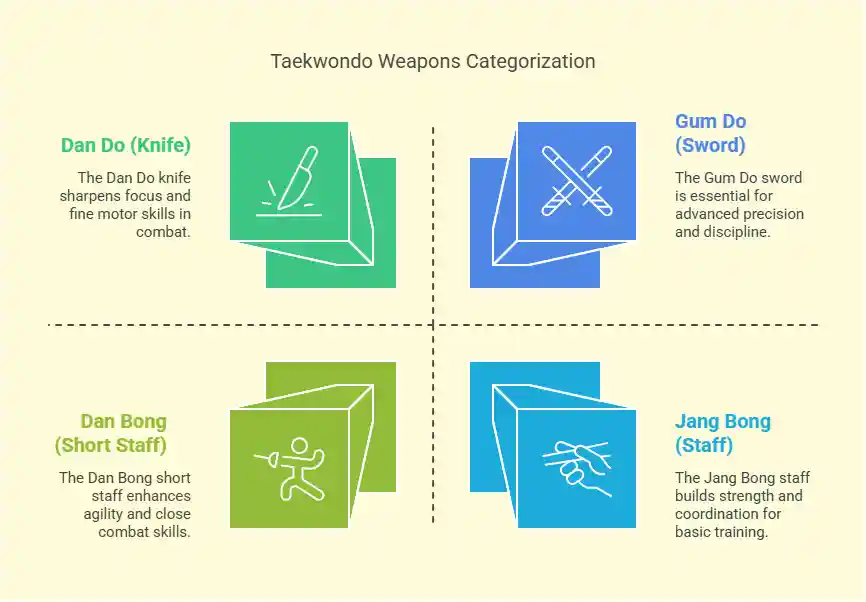
In Taekwondo, there are different types of weapons, like the Jang Bong (staff) and Gum Do (sword). Each weapon helps you improve different skills, such as timing and coordination. I remember learning each weapon and how it helped me grow in Taekwondo. Let’s explore the most common weapons used in Taekwondo.
Jang Bong (Staff)
The Jang Bong, or staff, is a key weapon in Taekwondo. It has been used for centuries in Korean martial arts. The staff is about six feet long. It helps build strength, balance, and coordination. In training, you learn how to block and strike with it. I remember feeling strong and focused the first time I used it. The Jang Bong is also used in demonstrations. It’s a great tool for learning control and precision.
Dan Bong (Short Staff)
The Dan Bong is a short staff, around three feet long. It is used for close-range combat. This weapon is quick and agile. It’s good for fast strikes and defense. The Dan Bong helps improve wrist movements and hand-eye coordination. I love how it teaches you to react fast in tight situations. It’s a useful tool for learning to stay balanced in close combat.
Gum Do (Sword)
The Gum Do, or sword, is for advanced Taekwondo students. It’s not just about swinging it. You learn precise moves, called Gum Do Forms. These forms include strikes, blocks, and cuts. The sword connects you to Taekwondo’s history. Training with the Gum Do teaches focus and mental strength. I found it challenging but rewarding. Using the sword sharpens your technique and discipline.
Dan Do (Knife)
The Dan Do, or knife, is used in close-range fighting. It’s a small weapon. The knife teaches precision and control. You learn how to strike quickly and defend with it. It also helps you focus on footwork and balance. When I used it in training, I realized how much attention to detail it requires. The knife is great for learning fine motor skills and quick reactions.
Other Weapons
Other weapons, like the Nunchaku and Sai, can sometimes appear in Taekwondo classes. These weapons are more common in other martial arts like Eskrima. While not standard in most Taekwondo schools, they can still be a fun way to challenge yourself. These weapons help with control and speed. They add variety to martial arts training, but are not the main focus of Taekwondo.
Each weapon in Taekwondo helps build focus, precision, and control. They may not be central to all training, but they enrich the practice. Learning these weapons can deepen your understanding of Taekwondo’s history and techniques.
The History and Military Connection of Taekwondo and Weapons

Taekwondo has roots in Korea’s military history. Early forms of Taekwondo, like Taekkyeon and Hwa Rang Do, used weapons in battle. Learning about this history gave me a deeper understanding of Taekwondo’s purpose. Let’s dive into how weapons have been part of Taekwondo’s story.
Taekwondo’s Military Origins
Taekwondo has deep roots in Korea’s military history. In ancient times, soldiers used Taekwondo to prepare for battle. They trained not only in hand-to-hand combat but also with weapons. The Jang Bong (staff) and Dan Bong (short staff) were important tools for defense. When I first learned about Taekwondo’s military origins, it made me appreciate the art even more. It wasn’t just about moves—it was about survival.
Was Taekwondo Used in War?
Yes, Taekwondo’s early forms, like Taekkyeon and Hwa Rang Do, were used in war. Taekkyeon was taught to soldiers for self-defense and fighting. Hwa Rang Do was used by elite warriors in Korea. These forms helped soldiers in hand-to-hand combat and with weapons like swords and staffs. Learning about this history made me realize how Taekwondo is more than a sport—it’s a way of life. It’s about respect, focus, and strength, just like the warriors who trained with it centuries ago.
Do You Use Arms in Taekwondo?

In Taekwondo, your arms are important for defense and offense. I learned early that strong, controlled arm movements are key for strikes and blocks. Your arms are just as important as your legs in Taekwondo. In this section, we’ll look at how your arms help in both unarmed and weapon training.
The Role of Arms in Taekwondo
In Taekwondo, your arms are very important. You use them for blocking and striking. When you throw a punch, it’s not just your hand; your whole arm and body help. Blocks are more than putting your arm in the way. They are about creating strength and control. I remember learning the Low Block. At first, it was awkward. But with practice, I felt my arms become strong, and my defense became more powerful. Your arms are key for both protecting yourself and attacking.
In weapon training, your arms still play a big role. When you use a Jang Bong (staff) or Dan Bong (short staff), you use your arms in the same way. The moves you learn in unarmed fighting transfer to weapon training. The motion feels different, but the control of your arms is the same.
Can Taekwondo Be Used in a Real Fight?
Yes, Taekwondo works in real-life situations. I once faced an unexpected threat while walking home at night. I used a front kick, a basic move from class, to push the person away and escape. It worked because I practiced my skills regularly. Taekwondo is not just for the dojo. It teaches focus and quick reactions. In real life, these skills help you stay calm and act fast.
Taekwondo also builds confidence and mental strength. It helps you stay calm under pressure. Whether you are unarmed or using a weapon, the training prepares you to protect yourself. Taekwondo teaches you not only how to fight but how to think in tough situations.
Taekwondo Weapon Training: What You Need to Know
Weapon training in Taekwondo helps you develop focus and precision. From my experience, using a Jang Bong helped me improve my balance and control. In this section, we’ll talk about when weapon training is introduced in Taekwondo and how it can make your practice stronger.
Is Weapon Training a Standard Part of Taekwondo?
Not every Taekwondo school teaches weapons. Many schools wait until you have learned the basics before introducing weapons. When I first started, I didn’t know weapons were part of Taekwondo. Later, when I was more advanced, my instructor showed us the Jang Bong (staff). That was when I realized how valuable weapon training could be. If your school offers it, give it a try!
How Weapon Training Enhances Taekwondo

Weapon training in Taekwondo helps you improve key skills. It teaches balance, coordination, and control. When I picked up the Jang Bong, I focused on staying balanced. With practice, I found my timing and movements became more precise. Weapons help you understand your body in new ways, even if you’re working without one.
Weapon training also teaches you about distance, timing, and control. Learning to use a weapon makes you better at reading your opponent. You learn to strike at the right moment and from the right distance. This improves your unarmed techniques too.
Finally, weapon training helps with focus and discipline. Every move with a weapon must be deliberate and controlled. When I trained with the Gum Do (sword), I had to focus carefully on each move. This discipline helps you in every part of your Taekwondo practice.
Conclusion
Taekwondo use weapons, like the Jang Bong and Gum Do, adding depth to training by teaching control, precision, and focus. While weapons aren’t part of every school’s curriculum, they offer valuable skills that improve balance, timing, and discipline. My own experience with weapons in Taekwondo helped me develop better control and made me appreciate the art even more. If you’re looking to enhance your practice, consider exploring weapon training—it’s a great way to deepen your Taekwondo journey.
Share Your Thoughts!
Have you ever tried Taekwondo weapon training? Share your experiences or thoughts in the comments below or connect with us on social media. We’d love to hear how weapons have impacted your practice!
FAQs
Are there weapons used in Taekwondo?
Yes, Taekwondo includes weapons like the Jang Bong (staff), Dan Bong (short staff), Gum Do (sword), and Dan Do (knife), typically taught to advanced students. Learn more about weapons in Taekwondo.
What types of weapons are used in Taekwondo?
Taekwondo uses weapons such as the Jang Bong (staff), Dan Bong (short staff), Gum Do (sword), and Dan Do (knife), which enhance control, precision, and discipline.
Do you use arms in Taekwondo?
Yes, arms are used in Taekwondo for strikes, blocks, and defense. They help in both unarmed and weapon training. Learn how arms play a key role in Taekwondo techniques.
Can Taekwondo be used in real-life combat or self-defense?
Yes, Taekwondo skills, such as quick strikes and kicks, are effective for self-defense and real-life situations. Practice makes you ready to react fast when needed.
Is Taekwondo’s weapon training the same as other Martial Arts like Karate or Kung Fu?
Weapon training in Taekwondo is similar but unique. Taekwondo focuses on precision, timing, and control with weapons like the staff and sword, compared to other martial arts.
Was Taekwondo used in war or military combat?
Yes, Taekwondo’s older forms, like Taekkyeon and Hwa Rang Do, were used by Korean warriors in combat and self-defense during wartime.
Can Taekwondo be learned without using weapons?
Yes, Taekwondo can be practiced without weapons. The focus is on striking, kicking, and discipline, and weapon training is optional or introduced later in practice.

Get Started Today!
If you’re new to Taekwondo or looking to expand your skills, consider signing up for beginner classes. Dive deeper into martial arts history and techniques to enhance your journey.

Founder, Owner, and CEO of TaekwondoKing.
He is one of the top 100 martial artists in the World and among the top 20 referees in Bangladesh.
Ehatasamul Alom is an esteemed Kukkiwon Certified Taekwondo 3rd Dan Black Belt with over 15 years of experience in this dynamic martial art. Born in Rajshahi, Bangladesh, Ehatasamul’s journey with Taekwondo began at the tender age of seven. His passion led him to compete at national and international levels, where he has bagged numerous awards and honors. He is also a member of the Taekwondo National Referee Panel.
With a Bachelor’s degree in Sports Science from the prestigious Rajshahi University, Ehatasamul has a deep understanding of the technical and scientific aspects of martial arts and some other martial arts.
In 2022, Ehatasamul created the “TaekwondoKing.com” to share his knowledge, Free Resources, Values, and Real experiences. His articles focus on Taekwondo training techniques, competition strategies, Sport Products Reviews, and the art’s rich history and philosophy. He also writes about the importance of mental fortitude and discipline, key aspects of his teaching philosophy. He has already launched many sports, Taekwondo, and health-related Free online tools. His goal is to inspire both beginners and seasoned practitioners worldwide through insightful and engaging content.
If you need any help, contact Ehatasamul Alom at any time.

